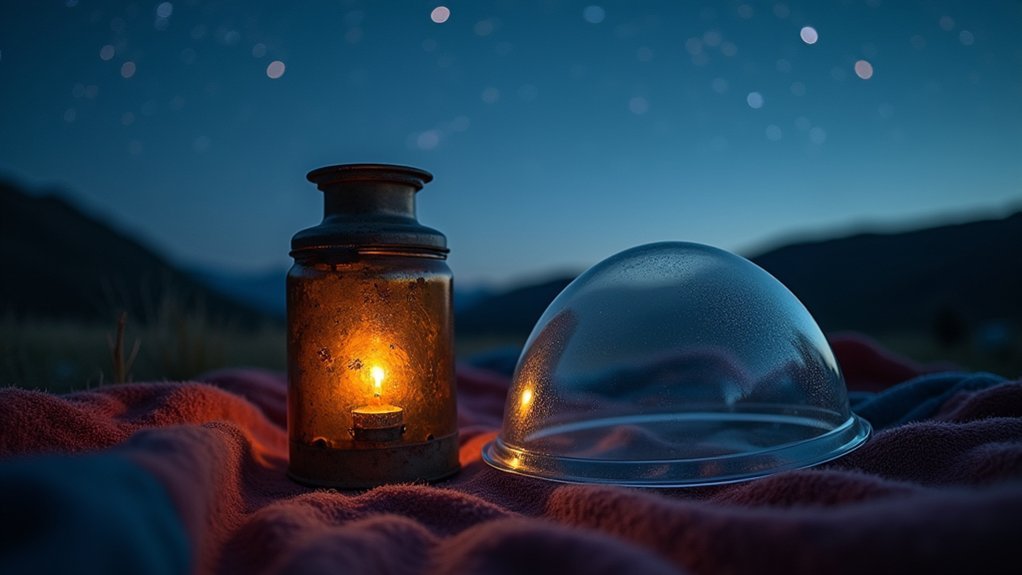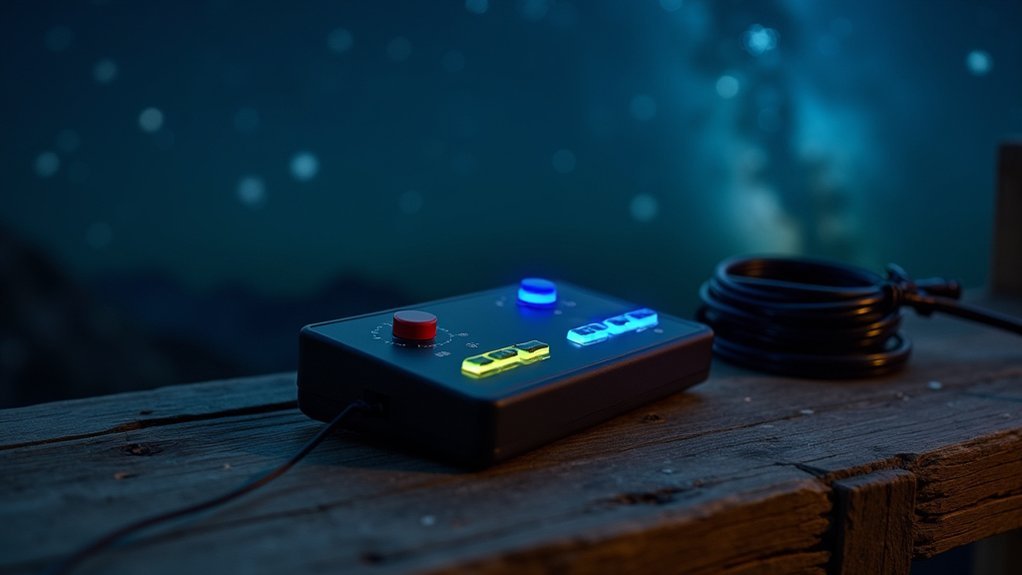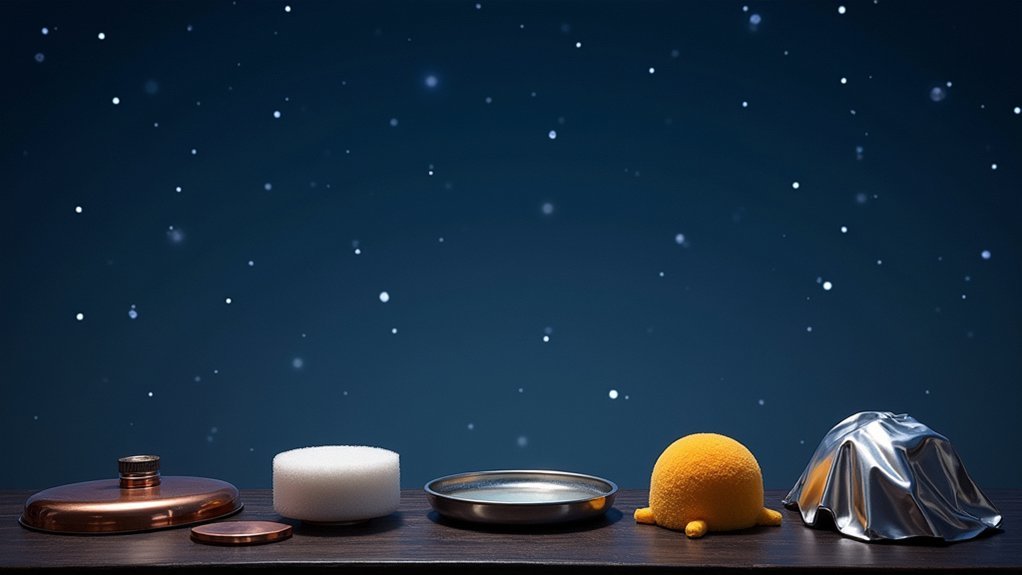Prevent telescope dew without breaking the bank with these five affordable solutions: DIY PWM controllers for $15, USB-powered dew strips for $6, chemical hand warmers at just $1.50 per setup, repurposed LED dimmers under $5, and reliable single-channel commercial controllers around $55. You’ll keep your optics clear during extended stargazing sessions while conserving battery life with these budget-friendly options. Each approach offers unique advantages depending on your specific astronomy needs.
Simple PWM Controllers: The $15 DIY Approach

While commercial dew controllers can cost upwards of $100, you can build your own pulse-width modulation (PWM) controller for a fraction of the price.
With just $15 worth of components including a 12V LED dimmer, insulated wire, and a plastic project box, you’ll create an effective dew heater controller that conserves battery life.
Start by gathering RCA sockets for connecting your dew heaters and install an inline fuse with chassis holder for essential safety.
Wire everything properly, using a multi-meter to check for shorts before final assembly.
For added functionality, incorporate a red LED indicator that shows when your heaters are active.
This DIY PWM controller provides adjustable power output, letting you apply just enough heat to prevent dew without draining your battery during long observation sessions.
USB-Powered Dew Strips: Convenience on a Budget
For stargazers seeking an ultra-affordable dew prevention option, USB-powered dew strips offer remarkable value at around $6 per strip on Amazon.
These budget-friendly accessories can be powered directly from any standard USB charger connected to your AC power strip at your observing site.
While they’re considerably cheaper than dedicated dew controllers, you’ll face some trade-offs.
USB-powered dew strips aren’t as energy-efficient as traditional controllers that utilize pulsed power delivery. This means they’ll draw more electricity during your observing sessions.
You might also find they’re somewhat less effective at preventing dew formation compared to premium solutions.
However, if you’re just starting out or need a temporary fix before investing in higher-end equipment, these strips provide a convenient, accessible solution that won’t break the bank.
Hand Warmer Hacks: Chemical Dew Prevention Under $10

The humble chemical hand warmer offers a surprisingly effective solution for amateur astronomers battling lens condensation. For just 75 cents each when bought in bulk, these portable heat sources can preserve your viewing session even in high humidity conditions.
You’ll find two hand warmers secured with a rubber band around your camera lens provides excellent dew control for about $1.50.
For larger telescopes, create a DIY dew heater by attaching eight hand warmers to duct tape, forming an effective strip for around $6.
This “ghetto dew heater” setup requires minimal preparation but delivers impressive results during extended observation sessions.
While not the most economical choice for nightly use, this cheap solution gives you reliable, immediate protection when unexpected dew threatens your stargazing plans.
Repurposed LED Dimmers: Transform Existing Hardware
Hiding in plain sight within your collection of lighting equipment, LED dimmers offer an ingenious pathway to affordable dew control.
Ordinary LED dimmers transform into astronomical assets, providing budget-friendly dew management solutions for dedicated stargazers.
These components, costing just £2.00-£5.00, can be repurposed to create efficient dew controllers that precisely manage power to your heating strips.
Unlike resistive methods that waste energy as heat, these repurposed LED dimmers utilize PWM output to deliver only the necessary power to your equipment.
Simply connect a dimmer to your 12V power source, and you’ll gain fine-tuned control over your dew heaters based on changing environmental conditions.
For enhanced functionality, add a red LED indicator to monitor operational status.
House everything in a protective project box to shield components from moisture and physical damage, ensuring your DIY dew controller remains reliable throughout your stargazing sessions.
Single-Channel Commercial Controllers Worth Their Price

While DIY options offer creativity, several single-channel commercial dew controllers deliver exceptional value without exceeding modest budgets.
At $55.00, the standard single-channel dew controller provides reliable dew prevention that works great for most stargazing sessions. Many users report consistent performance without the overheating issues that plague cheaper alternatives.
The 4Tronix single-channel controller, available for £54, offers similar dependability with an included power supply that’s ready to use straight out of the box.
Though more expensive options like the Pegasus 2-channel ($90) provide automated adjustments, these budget-friendly single-channel models handle the essential task effectively.
Investing in a quality controller now means you’ll avoid the frustration and expense of replacing ineffective solutions repeatedly.
For most amateur astronomers, these affordable commercial options strike the perfect balance between cost and functionality.
Frequently Asked Questions
How Does Humid Climate Affect Dew Controller Requirements?
In humid climates, you’ll need more powerful dew controllers with higher wattage to combat moisture effectively. You’re also facing faster dew formation, so you’ll want controllers with variable settings and longer operating times.
Can Dew Controllers Run on Portable Battery Packs?
Yes, you can power dew controllers with portable battery packs. Most models run efficiently on 12V power banks or lithium batteries, making them perfect for remote stargazing sessions where outlets aren’t available.
What Telescope Materials Are Most Susceptible to Dew Formation?
Your optical glass surfaces are most susceptible to dew formation, especially mirrors and lenses. Metal components can also collect moisture, but it’s your primary optical elements that’ll suffer most from condensation during nighttime viewing.
How Much Power Does a Typical Dew Controller Consume?
You’ll find typical dew controllers consume between 5-50 watts depending on their size. Most amateur astronomy setups use around 12-24 watts when actively heating, drawing about 1-2 amps from a 12V power source.
Are Bluetooth-Enabled Dew Controllers Worth the Extra Cost?
Bluetooth-enabled dew controllers aren’t worth the extra cost for most users. You’ll rarely need remote adjustments during observation sessions, and standard models offer similar performance. Save your money unless you’re controlling multiple telescopes simultaneously.
In Summary
You don’t need to spend a fortune to keep dew at bay during your stargazing sessions. Whether you’re crafting a DIY PWM controller, using USB-powered strips, applying chemical hand warmers, repurposing LED dimmers, or investing in an affordable commercial solution, you’ve got options that protect your equipment without breaking the bank. Choose what fits your comfort level, technical skills, and budget—clear views are now within everyone’s reach.





Leave a Reply